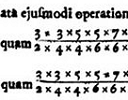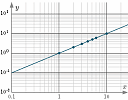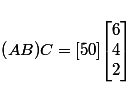IntMath Newsletter: Rankbrain, Wallis, log-log and scalars
By Murray Bourne, 26 Nov 2015
26 Nov 2015
In this Newsletter:
1. Math in the news
2. Resource: Semilog and log-log page
3. Is a 1x1 matrix a scalar?
4. Math puzzles
5. Math movies: Comics that ask "what if?"
6. Final thought: Just do it!
1. Math in the news
a. Google Rankbrain
Google has been remarkably successful as a search engine due to its uncanny ability to (mostly) find the exact page we need in response to the questions we throw at it.
But that's because we ask similar questions most of the time, and those questions are fairly unambiguous (like "weather New York", or "formula for area of circle", or perhaps "flights to London".)
However, around 15% of all Google queries are novel (no-one has asked it before) and/or may require natural language interpretation (for example the question, "What time does it get dark in the Philippines?" requires an understanding of the term "get dark"). This has proved quite a challenge for Google (and its competitors), but like the rest of their approach, math has come to the rescue.
Google's Rankbrain is a new vector-based artificial intelligence approach to the problem of what natural language searches could mean. These "word vectors" are basically the result of assigning numbers to possible meanings of words. If the vectors line up sufficiently well, then that's probably what the query really means.
According to Google’s Chief Executive Officer Sundar Pichai:
“Machine learning is a core transformative way by which we are rethinking everything we are doing.”
There could be some job opportunities in this going forward. (Google has hired many aritifical intelligence scientists over the last few years.)
For more details:
Google Turning Its Lucrative Web Search Over to AI Machines (by Bloomberg)
"Thought vectors" could revolutionize artificial intelligence (by ExtremeTech)
b. Wallis, pi and quantum theory
Seventeenth century English mathematician John Wallis developed an approximation for π involving the product of simple fractions. His result was recently proved in a novel way involving quantum theory.
Wallis contributed quite a few other mathematical insights, some of which I outline in this article.
 |
A quite remarkable new proof of the 400 year-old Wallis Product approximation for π has recently been published. It arises from a study of the quantum mechanics of the hydrogen atom. |
2. Resource: Semi-log and log-log Graphs
I find a lot of people don't readily grasp the concept of semi-log or log-log graphs, so when they come across a statistical graph containing such axes, they complain it is "misleading" (They are used to the axes always having equally-space gaps.)
 |
I recently updated the IntMath page on semi-log and log-log axes. The page concludes with an interesting real-life case of log-log graphs, the Zipf Distribution. |
3. Is a 1×1 matrix a scalar?
 |
A 1x1 matrix is often regarded as a scalar quantity, but is that correct? This article explores a reader's question. |
4. Math puzzles
The puzzle in the last IntMath Newsletter asked about division of a factorial number.
Correct answers with explanation were given by: Don and Tomas (who both used a software approach), and Francis, Salomon and Γιώργος Βαρελάς (Giorgos Varelas) (who enumerated all possible cases).
There were a few "traps" for the unwary in that puzzle, including the "factorial" sign (!) which some people missed altogether (understandable, sine it's not good math notation), and the "divide into" terminology.
For those who are still not sure what's going on, here's a simpler example: The number 5! can be divided evenly by 2 three times, since there are three 2's in the prime factorisation of 5!:
5! = 120 = 2 × 2 × 2 × 3 × 5
New math puzzle
An ant on a sheet of coordinate paper starts at the point (3,4), proceeds
by a straight line path to the nearest point on the unit circle, and then
follows the arc of the circle to the point (1,0). How far did the ant walk? (Units are cm.)
You can leave your responses here.
5. Math movie: Randall Munroe: Comics that ask "what if?"
I've been a XKCD comics fan for some time since his simple stick figure cartoons are often thought-provoking and are often math-related. His tagline is:
A webcomic of romance, sarcasm, math, and language
(Some of the topics discussed may not be suitable for all ages. Make your own determination.)
He gets a lot of crazy questions from readers which he addresses in the What if? section.
Here's his TED talk about some of those questions, and his responses.
 |
Web cartoonist Randall Munroe answers simple what-if questions ("what if you hit a baseball moving at the speed of light?") using math, physics, logic and deadpan humor. |
6. Final thought: Just do it!
Today's quote comes from Butch Lovelace. It's for those of you who struggle to get going some days:
The most difficult thing is to just start the ball rolling. Once it starts, it's actually more difficult to stop it. [Butch Lovelace]
Until next time, enjoy whatever you learn.
See the 16 Comments below.

26 Nov 2015 at 5:51 pm [Comment permalink]
What a great question. I'm giving it to my 6th Form next lesson. When I just solved it, the key was working out where the nearest point was. Like most maths, a good diagram pays dividends 🙂
26 Nov 2015 at 7:02 pm [Comment permalink]
@Tim: Great! How did your lesson go?
26 Nov 2015 at 9:45 pm [Comment permalink]
The answer is 5.4142135
26 Nov 2015 at 10:58 pm [Comment permalink]
I'm sorry, Dave. I'm afraid I can't do that.
Something messed up. :-(